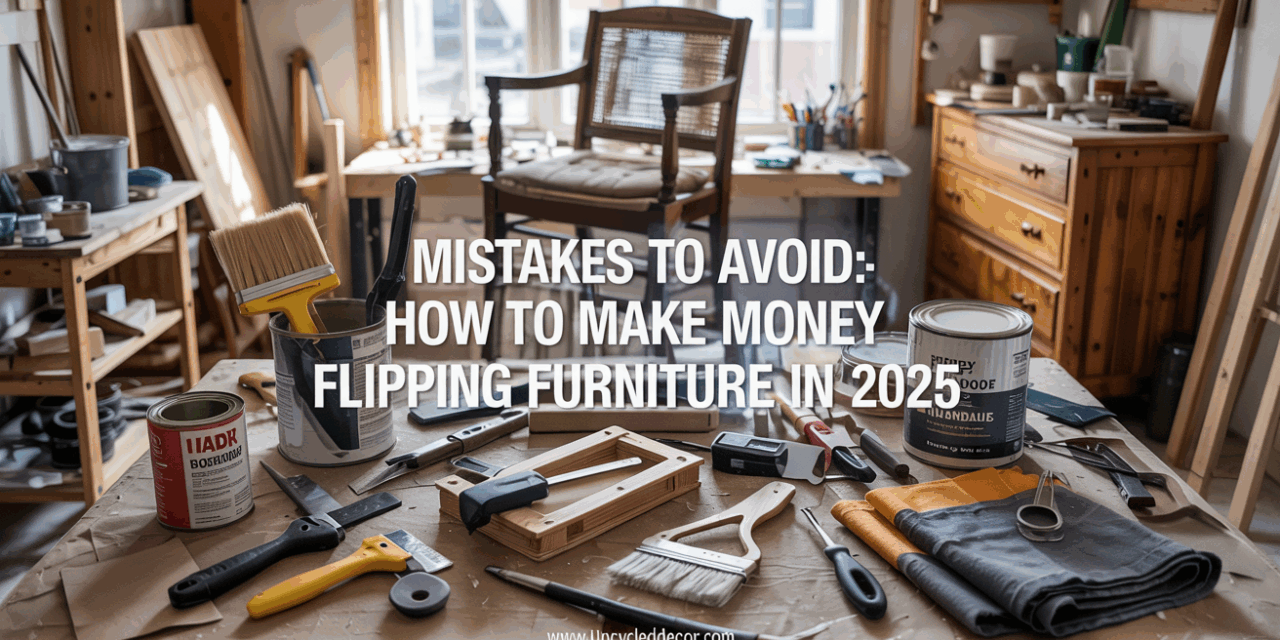This article about essential tools to make money furniture flipping that will help you make more money in your furniture flipping and vintage decor resale business.
This post may contain affiliate links, which means I’ll receive a commission if you purchase through my link, at no extra cost to you. I am an Amazon Associate. Please read full disclosure here.
In this article, we’ll cover the essential tips for furniture flipping beginners. We’ll talk about the business model, marketing, and pricing. Whether you’re starting a side hustle or a full-time business, this guide will help you get started.
Our journey began at a thrift store, where we found four chairs for $25. We didn’t need them, but we knew we could sell them for more. This taught us the value of finding the right pieces by being in the right place at the right time. We began going on Tuesday mornings to three Goodwills near us. Many people agree that Monday and Tuesday mornings at Goodwill are best for pickers.
In this article, we’ll cover the essential tips for furniture flipping beginners. We’ll talk about the business model, marketing, and pricing. Whether you’re starting a side hustle or a full-time business, this guide will help you get started.
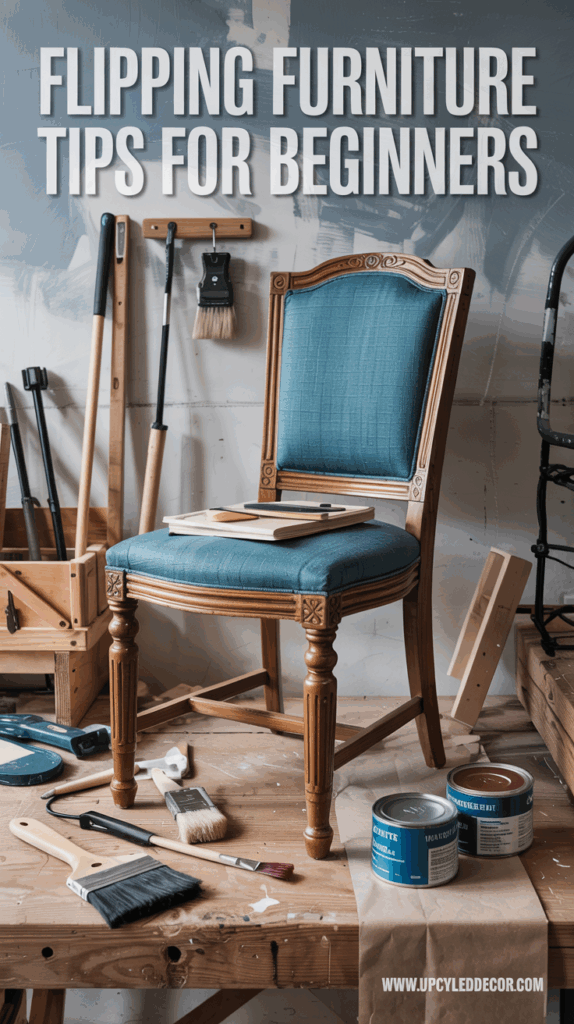
Understanding the Business Model: How to Make Money Flipping Furniture
Furniture flipping is a rewarding way to make money, but it demands effort and dedication. With the right skills, you can transform old furniture into pieces that people will cherish. We’ll share the essential tips you need to succeed in furniture flipping.
To succeed in furniture flipping, you need to understand the business model. It’s about knowing what makes it profitable. This includes looking at market demand and finding furniture sources. A good furniture flipping business model helps you plan and make smart choices.
Having the right tools for furniture flipping is key. You’ll need things like sanders, paint, and upholstery materials. These tools help you flip furniture well, which can lead to more profit.
When starting, think about what makes furniture profitable. Look at the cost, selling price, and restoration time. A furniture flipping must have list helps you pick the most profitable items.
- Analyze market demand to identify in-demand pieces
- Research potential sources of furniture, such as thrift stores and estate sales
- Calculate the potential return on investment for each piece
Understanding the business model and having the right tools are crucial for success. Stay focused on your market and adjust your plan as needed.
You’re Not Treating It Like a Business (and It’s Costing You)
Let’s not take ourselves too seriously—you’re reselling thrift store decor and curbside finds, not launching a Silicon Valley startup. But the beauty of this business is that you can start small and still think big.
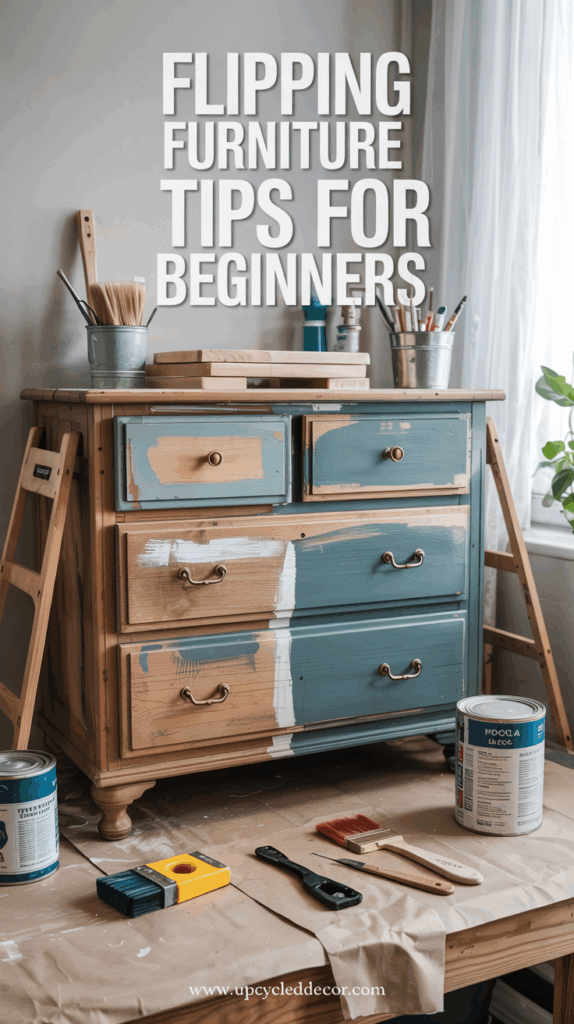
If you want to become a master restorer, you can totally go that route. Practice on small pieces, learn moderate repairs, and work your way up to serious restoration.
On the flip side, if you’re obsessed with vintage style, you can branch out and build a brand around that. There’s room here for a lot of paths—but only if you stop treating it like a hobby.
Too many flippers stay stuck in “I-can’t-believe-someone-paid-me-for-this-trash” mode. They’re embarrassed to charge what it’s worth. They’re surprised anyone’s buying it at all. So they underprice, accept whatever offers come in, and call it a win.
But here’s the thing: when you start approaching this like a real business, you’ll start seeing real business opportunities.
Start asking business-level questions:
- Who is your target customer?
- What kinds of pieces sell fastest—and to whom?
- Are black-painted desks selling better than white-painted end tables?
- Do your buyers care more about price, style, reviews, or location?
- What platforms bring you the best ROI?
Most people don’t ask. Which is exactly why you should.
The truth? Mistakes that seem small now will scale way up if you’re doing 10–20 flips a month. That pricing slip-up, that poor description, that under-researched piece? They add up fast.
You Underprice Based on Cost, Not Value
The mistake: foucsing on your costs. They tally up what they spent—$10 on the chair, $5 on paint, maybe $3 on new knobs—and then slap on a price that just barely covers it with a little “profit.”
The reality: you should be pricing based on value. That is not how resale works. Just because you got it cheap doesn’t mean it’s worth less. If the comps show similar chairs selling for $100, why are you listing yours for $40 just because you got it for free?
Real talk: my free $150 barstools. I once picked up a set of barstools off the curb. Free. Sold them for $150. Would I have been happy with $100? Sure. But I also would’ve underpriced by *50%.*
Now multiply that by 10 flips a month. Or 20. That pricing mindset doesn’t just leave money on the table—it kills your business at scale. Buzz. Kill.
Do this instead when pricing for your flipping furniture business:
- Start with comps, not costs.
- Think resale *value*, not “how much you paid.”
- Just because you’re flipping doesn’t mean you have to be cheap.
You Overprice Because You’re Emotionally Attached
The mistake: You gave the dresser a name. You hand-painted the drawers with gold trim. You lovingly sanded for hours while listening to Taylor Swift and twirling down memory lane. Now you want $275 for a $75 flip.
The reality: When you fall in love with your inventory, you lose objectivity. That’s how you end up hoarding instead of flipping—and turning your workspace into a furniture graveyard.
What to do instead:
- Don’t name the farm animals.
- Know your market and detach emotionally before pricing.
- Ask yourself: “Would I buy this at that price if I hadn’t made it?” (If the answer is no… fix your price.)
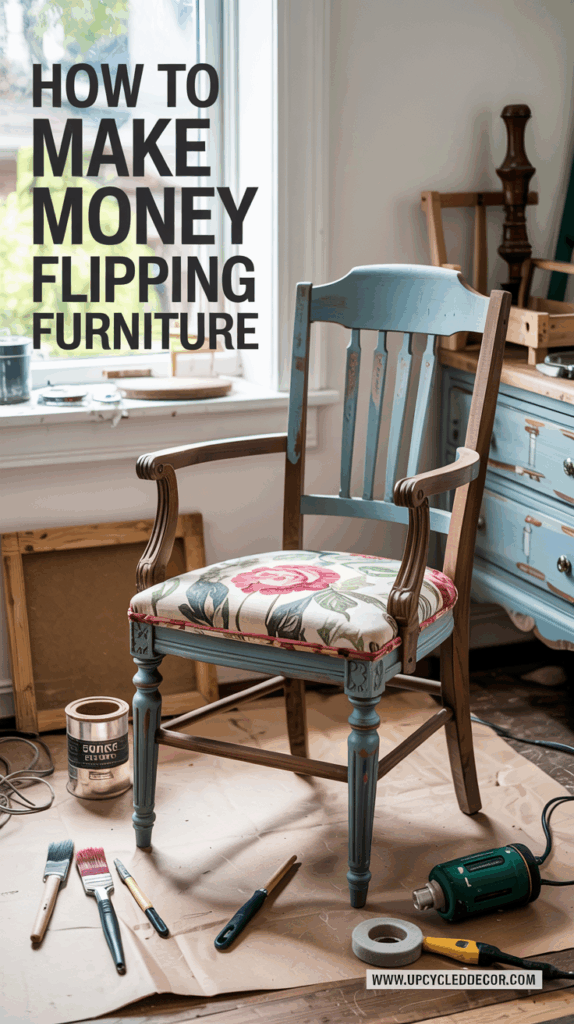
You Think You’re an Interior Designer. You’re Not. (Yet.)
The mistake: You’re doing full-blown makeovers on every flip—chalk paint, decoupage, gold leaf, the works. New flippers burn hours (and cash) on full paint jobs, fancy finishes, and $12 Anthropologie knobs for a $40 dresser. That’s not flipping, that’s unpaid interior design.
The reality: Restoration is beautiful, but flipping is a numbers game. If your margin dies on the workbench, it wasn’t a flip—it was a hobby.
What to do instead: Flipping is about margin, not emotional fulfillment. A piece doesn’t need to be perfect—it needs to be sellable.
- Use the least amount of paint possible to get the piece sold.
- Upgrade hardware only if it raises the value.
- Time yourself. Your labor is a cost. Act like it.
Setting Up Your Flipping Workspace
A well-organized workspace is key to how to make money flipping furniture. Think about how you work and set up your space logically. This makes you work better, cuts down on waste, and keeps you safe.
Having a space just for flipping furniture helps you stay on track. You’ll need good storage and safety gear. This setup lets you focus on making money from flipping furniture.
When setting up your workspace, consider these important things:
- Workbenches and tables for working on projects
- Storage solutions for tools and materials
- Safety equipment, such as gloves and safety glasses
- A well-ventilated area for painting and staining
With a well-organized workspace, you’ll work better and make more money. This means you can take on more projects and grow your business. Success in furniture flipping is within reach.
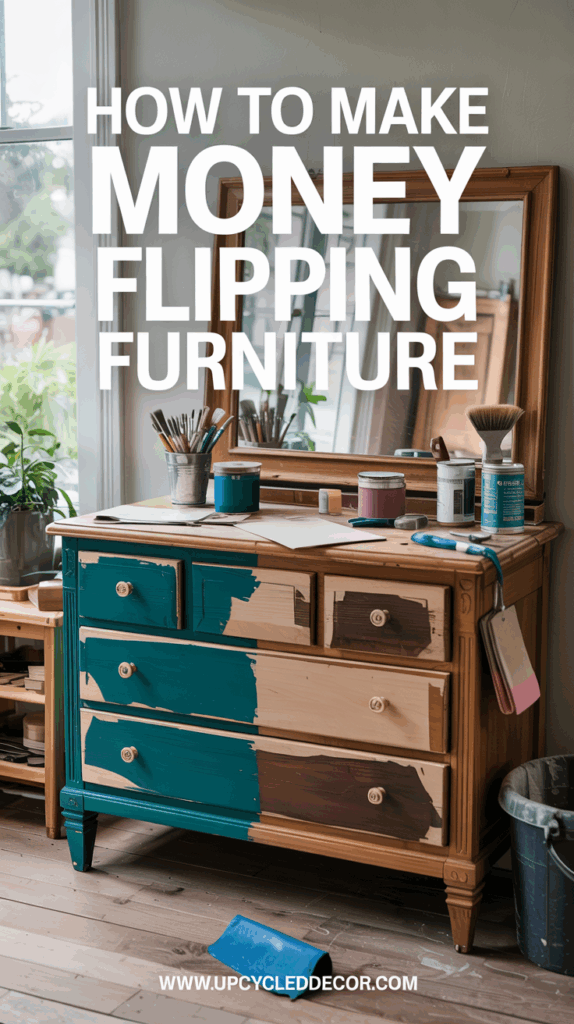
Sourcing Profitable Furniture Pieces
To do well in the furniture flipping business, you need to spot good pieces. Look for items that are affordable and in good shape. Also, try to get them for a low price. Start with simple projects and then move on to harder ones.
Begin by checking out thrift stores, estate sales, and online sites. These places often have items at lower prices. It’s also key to know what people want and how much you can sell it for. This helps you make smart choices and avoid losing money.
Some great places to find furniture include:
- Local thrift stores and charity shops
- Estate sales and auctions
- Online marketplaces like Craigslist and Facebook Marketplace
- Garage sales and yard sales
By using these tips, you can find great pieces and grow your furniture flipping business.

This was one of our early and easy furniture flipping projects: we found these curbside chairs and updated with simple black paint and recovered the seats with an upcycled shower curtain. Read about this easy chair makeover here.
Remember to keep your goals and who you’re selling to in mind. With the right approach, you can make your furniture flipping business a success.
You Need to Build Your Furniture Flipping Brand
Creating a strong furniture flipping brand is key to your furniture flipping business’s success. It means having a unique identity, a consistent style, and a strong online presence. By focusing on furniture flipping for profit, you can boost your earnings and grow your business.
To attract and keep loyal customers, focus on your target market. Adjust your strategy to meet their needs. Here’s how:
- Develop a consistent style and aesthetic
- Create high-quality products that meet customer needs
- Provide excellent customer service
Building a strong furniture flipping brand helps you gain a reputation for quality and excellence. This leads to more loyal customers and helps your business grow. As a result, you can make more money from furniture flipping for profit.
Marketing Strategies for Your Furniture Flipping Business
As a furniture flipper, having a good marketing plan is key to getting new customers and selling more. Furniture flipping marketing means having a strong online presence, showing off your work, and being known in your area. For furniture flipping for beginners, start with easy and cheap marketing ideas. Then, grow your efforts as your business gets bigger.
Good marketing ideas include making a social media account, taking great photos of your work, and using local online shops. You can also post your furniture flipping ideas and projects on social media. This helps you connect with people who might buy from you and builds your brand. Using these tactics can make you more visible, get you loyal customers, and boost sales.
- Use the right hashtags to get seen online more
- Work with local interior designers or home stagers to show off your work
- Give workshops or classes on furniture flipping and restoration
By using these marketing strategies and focusing on your audience, you can make your furniture flipping business a success. Always keep your marketing in line with your brand and audience. Also, always check and change your strategies to get the best results.
Pricing and Profit Margins in Furniture Flipping
Your cash flow is a cash crash: know your numbers
The mistake: You’re Venmo’ing, cash App’ing, and praying no one ever audits your shoebox full of receipts. “Profit” is just whatever cash you didn’t spend yet.
The reality: This is a business. If you don’t know what each piece made you, you’re just winging it—and you can’t grow what you don’t measure.
What to do instead:
- Log every flip: purchase cost, materials, time, sale price, profit.
- Use a spreadsheet, app, or good old-fashioned notebook.
- Track your ROI and make decisions based on facts, not feelings.
Once you’re tracking numbers, get strategic about how you price. Understanding pricing is key in furniture flipping for profit. Furniture flipping pricing means figuring out material costs, labor, and the value of your pieces. To succeed, you must set prices that are both profitable and competitive.
Researching your market is vital. Knowing what customers pay for similar items helps set the right price. This ensures you make a profit while staying competitive. By considering all costs, you can craft a pricing plan that suits your business.
When pricing your furniture, consider these factors:
- Cost of materials and supplies
- Time and labor invested in the project
- Market demand and competition
- Target profit margin
As you grow, you can tweak your pricing to highlight your unique value. This might mean focusing on high-end items or targeting specific customers. Keeping an eye on your pricing and profit margins is crucial for your business’s long-term success.
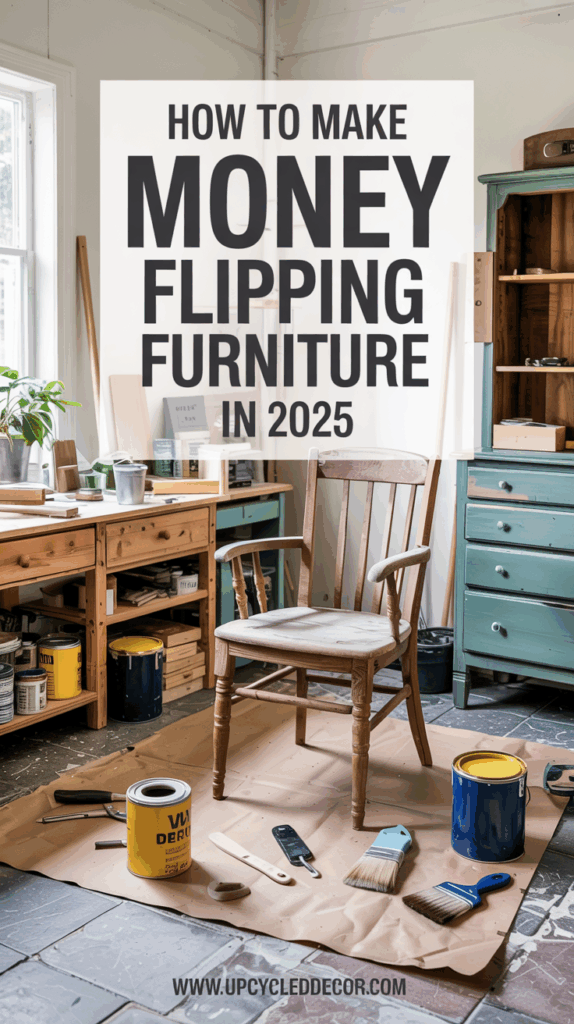
Don’t forget to share and save!
You’re Waiting to Feel Ready
The mistake: You’re waiting until you know everything—until you’ve watched 47 YouTube tutorials, built the perfect workspace, bought the right sander, and found the “perfect” flip.
The reality: Readiness is a myth. You learn by doing. You get good by getting started. The flippers making money aren’t the ones with the fanciest gear—they’re the ones who listed something.
What to do instead:
- Start with what you’ve got—even if it’s just a paintbrush and a folding table.
- Make your first flip about progress, not profit.
- Every flip teaches you more than any blog post (even this one).
- Action beats perfection. Get in the game, then level up.
Starting Your Furniture Flipping Journey
Starting a furniture flipping business is an exciting journey. It’s filled with creative possibilities and the chance for good financial returns. By using these essential furniture flipping business tips, you’re on your way to a thriving business. Success in this field needs dedication, adaptability, and a desire to keep learning.
Whether you’re new to furniture flipping or have experience, view each project as a new chance. Keep an eye on market trends, listen to your customers, and try new techniques and designs. With hard work, smart planning, and a love for making furniture beautiful, you can make your furniture flipping dreams come true.
If you’re ready to take your furniture flipping business to a five-figure business, read this.
IF you want a fast and easy chair makeover using an upcycled shower curtain (yes, really) read this.

